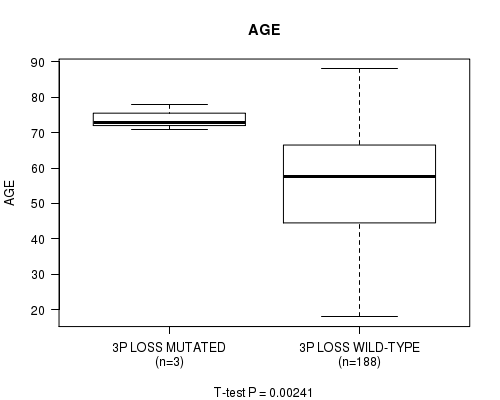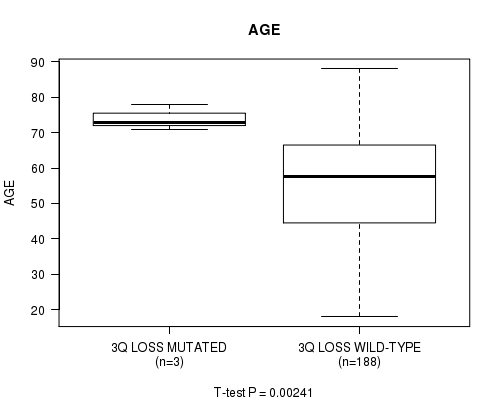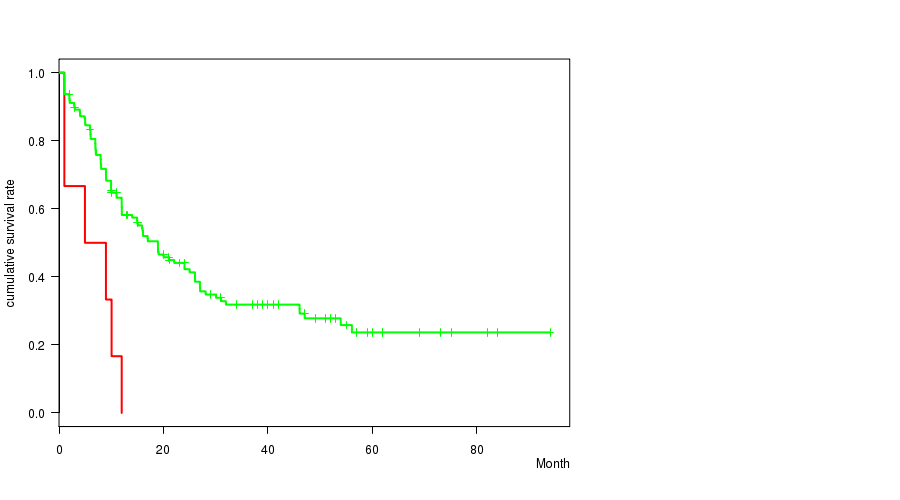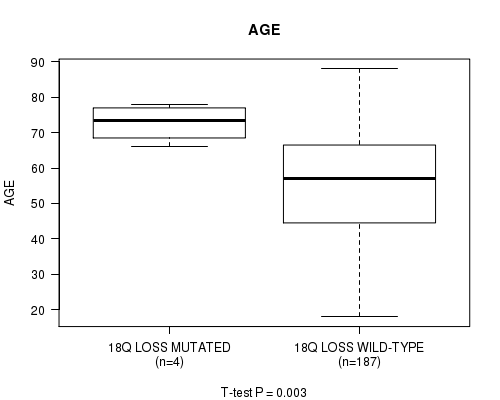This pipeline computes the correlation between significant arm-level copy number variations (cnvs) and selected clinical features.
Testing the association between copy number variation 30 arm-level events and 3 clinical features across 191 patients, 6 significant findings detected with Q value < 0.25.
-
3P LOSS MUTATION ANALYSIS cnv correlated to 'AGE'.
-
3Q LOSS MUTATION ANALYSIS cnv correlated to 'AGE'.
-
5Q LOSS MUTATION ANALYSIS cnv correlated to 'Time to Death'.
-
18P LOSS MUTATION ANALYSIS cnv correlated to 'Time to Death'.
-
18Q LOSS MUTATION ANALYSIS cnv correlated to 'Time to Death' and 'AGE'.
Table 1. Get Full Table Overview of the association between significant copy number variation of 30 arm-level events and 3 clinical features. Shown in the table are P values (Q values). Thresholded by Q value < 0.25, 6 significant findings detected.
|
Clinical Features |
Time to Death |
AGE | GENDER | ||
| nCNV (%) | nWild-Type | logrank test | t-test | Fisher's exact test | |
| 18Q LOSS MUTATION ANALYSIS | 4 (2%) | 187 |
0.000715 (0.0586) |
0.003 (0.234) |
0.127 (1.00) |
| 3P LOSS MUTATION ANALYSIS | 3 (2%) | 188 |
0.00241 (0.193) |
0.252 (1.00) |
|
| 3Q LOSS MUTATION ANALYSIS | 3 (2%) | 188 |
0.00241 (0.193) |
0.252 (1.00) |
|
| 5Q LOSS MUTATION ANALYSIS | 6 (3%) | 185 |
0.000679 (0.0563) |
0.0601 (1.00) |
0.0325 (1.00) |
| 18P LOSS MUTATION ANALYSIS | 5 (3%) | 186 |
0.00184 (0.149) |
0.355 (1.00) |
0.0642 (1.00) |
| 1P GAIN MUTATION ANALYSIS | 3 (2%) | 188 |
0.0913 (1.00) |
0.592 (1.00) |
|
| 4P GAIN MUTATION ANALYSIS | 4 (2%) | 187 |
0.599 (1.00) |
0.425 (1.00) |
0.627 (1.00) |
| 4Q GAIN MUTATION ANALYSIS | 4 (2%) | 187 |
0.599 (1.00) |
0.425 (1.00) |
0.627 (1.00) |
| 8P GAIN MUTATION ANALYSIS | 22 (12%) | 169 |
0.479 (1.00) |
0.072 (1.00) |
0.0734 (1.00) |
| 8Q GAIN MUTATION ANALYSIS | 23 (12%) | 168 |
0.523 (1.00) |
0.106 (1.00) |
0.0723 (1.00) |
| 10Q GAIN MUTATION ANALYSIS | 3 (2%) | 188 |
0.947 (1.00) |
0.252 (1.00) |
|
| 11P GAIN MUTATION ANALYSIS | 4 (2%) | 187 |
0.188 (1.00) |
1 (1.00) |
|
| 11Q GAIN MUTATION ANALYSIS | 7 (4%) | 184 |
0.553 (1.00) |
0.0154 (1.00) |
1 (1.00) |
| 13Q GAIN MUTATION ANALYSIS | 6 (3%) | 185 |
0.802 (1.00) |
0.143 (1.00) |
0.69 (1.00) |
| 17Q GAIN MUTATION ANALYSIS | 3 (2%) | 188 |
0.713 (1.00) |
0.29 (1.00) |
1 (1.00) |
| 19P GAIN MUTATION ANALYSIS | 6 (3%) | 185 |
0.958 (1.00) |
0.99 (1.00) |
0.223 (1.00) |
| 19Q GAIN MUTATION ANALYSIS | 6 (3%) | 185 |
0.958 (1.00) |
0.99 (1.00) |
0.223 (1.00) |
| 21Q GAIN MUTATION ANALYSIS | 8 (4%) | 183 |
0.0165 (1.00) |
0.616 (1.00) |
0.0732 (1.00) |
| 22Q GAIN MUTATION ANALYSIS | 9 (5%) | 182 |
0.707 (1.00) |
0.0339 (1.00) |
0.513 (1.00) |
| XQ GAIN MUTATION ANALYSIS | 3 (2%) | 188 |
0.0894 (1.00) |
1 (1.00) |
|
| 7P LOSS MUTATION ANALYSIS | 17 (9%) | 174 |
0.0748 (1.00) |
0.171 (1.00) |
0.802 (1.00) |
| 7Q LOSS MUTATION ANALYSIS | 20 (10%) | 171 |
0.0352 (1.00) |
0.18 (1.00) |
1 (1.00) |
| 12P LOSS MUTATION ANALYSIS | 4 (2%) | 187 |
0.752 (1.00) |
0.627 (1.00) |
|
| 15Q LOSS MUTATION ANALYSIS | 4 (2%) | 187 |
0.656 (1.00) |
0.277 (1.00) |
1 (1.00) |
| 16Q LOSS MUTATION ANALYSIS | 4 (2%) | 187 |
0.0587 (1.00) |
0.365 (1.00) |
0.627 (1.00) |
| 17P LOSS MUTATION ANALYSIS | 13 (7%) | 178 |
0.0993 (1.00) |
0.783 (1.00) |
0.147 (1.00) |
| 17Q LOSS MUTATION ANALYSIS | 7 (4%) | 184 |
0.385 (1.00) |
0.164 (1.00) |
0.458 (1.00) |
| 19P LOSS MUTATION ANALYSIS | 4 (2%) | 187 |
0.0509 (1.00) |
0.0534 (1.00) |
1 (1.00) |
| 19Q LOSS MUTATION ANALYSIS | 4 (2%) | 187 |
0.0509 (1.00) |
0.0534 (1.00) |
1 (1.00) |
| XQ LOSS MUTATION ANALYSIS | 5 (3%) | 186 |
0.174 (1.00) |
0.0197 (1.00) |
0.0642 (1.00) |
P value = 0.00241 (t-test), Q value = 0.19
Table S1. Gene #16: '3P LOSS MUTATION STATUS' versus Clinical Feature #2: 'AGE'
| nPatients | Mean (Std.Dev) | |
|---|---|---|
| ALL | 191 | 55.2 (16.1) |
| 3P LOSS MUTATED | 3 | 74.0 (3.6) |
| 3P LOSS WILD-TYPE | 188 | 54.9 (16.0) |
Figure S1. Get High-res Image Gene #16: '3P LOSS MUTATION STATUS' versus Clinical Feature #2: 'AGE'

P value = 0.00241 (t-test), Q value = 0.19
Table S2. Gene #17: '3Q LOSS MUTATION STATUS' versus Clinical Feature #2: 'AGE'
| nPatients | Mean (Std.Dev) | |
|---|---|---|
| ALL | 191 | 55.2 (16.1) |
| 3Q LOSS MUTATED | 3 | 74.0 (3.6) |
| 3Q LOSS WILD-TYPE | 188 | 54.9 (16.0) |
Figure S2. Get High-res Image Gene #17: '3Q LOSS MUTATION STATUS' versus Clinical Feature #2: 'AGE'

P value = 0.000679 (logrank test), Q value = 0.056
Table S3. Gene #18: '5Q LOSS MUTATION STATUS' versus Clinical Feature #1: 'Time to Death'
| nPatients | nDeath | Duration Range (Median), Month | |
|---|---|---|---|
| ALL | 166 | 104 | 0.9 - 94.1 (12.0) |
| 5Q LOSS MUTATED | 6 | 6 | 1.0 - 12.0 (7.0) |
| 5Q LOSS WILD-TYPE | 160 | 98 | 0.9 - 94.1 (12.5) |
Figure S3. Get High-res Image Gene #18: '5Q LOSS MUTATION STATUS' versus Clinical Feature #1: 'Time to Death'

P value = 0.00184 (logrank test), Q value = 0.15
Table S4. Gene #26: '18P LOSS MUTATION STATUS' versus Clinical Feature #1: 'Time to Death'
| nPatients | nDeath | Duration Range (Median), Month | |
|---|---|---|---|
| ALL | 166 | 104 | 0.9 - 94.1 (12.0) |
| 18P LOSS MUTATED | 5 | 5 | 1.0 - 12.0 (7.0) |
| 18P LOSS WILD-TYPE | 161 | 99 | 0.9 - 94.1 (12.0) |
Figure S4. Get High-res Image Gene #26: '18P LOSS MUTATION STATUS' versus Clinical Feature #1: 'Time to Death'

P value = 0.000715 (logrank test), Q value = 0.059
Table S5. Gene #27: '18Q LOSS MUTATION STATUS' versus Clinical Feature #1: 'Time to Death'
| nPatients | nDeath | Duration Range (Median), Month | |
|---|---|---|---|
| ALL | 166 | 104 | 0.9 - 94.1 (12.0) |
| 18Q LOSS MUTATED | 4 | 4 | 1.0 - 10.0 (4.5) |
| 18Q LOSS WILD-TYPE | 162 | 100 | 0.9 - 94.1 (12.0) |
Figure S5. Get High-res Image Gene #27: '18Q LOSS MUTATION STATUS' versus Clinical Feature #1: 'Time to Death'

P value = 0.003 (t-test), Q value = 0.23
Table S6. Gene #27: '18Q LOSS MUTATION STATUS' versus Clinical Feature #2: 'AGE'
| nPatients | Mean (Std.Dev) | |
|---|---|---|
| ALL | 191 | 55.2 (16.1) |
| 18Q LOSS MUTATED | 4 | 72.8 (5.4) |
| 18Q LOSS WILD-TYPE | 187 | 54.8 (16.0) |
Figure S6. Get High-res Image Gene #27: '18Q LOSS MUTATION STATUS' versus Clinical Feature #2: 'AGE'

-
Copy number data file = transformed.cor.cli.txt
-
Clinical data file = LAML-TB.clin.merged.picked.txt
-
Number of patients = 191
-
Number of significantly arm-level cnvs = 30
-
Number of selected clinical features = 3
-
Exclude regions that fewer than K tumors have mutations, K = 3
For survival clinical features, the Kaplan-Meier survival curves of tumors with and without gene mutations were plotted and the statistical significance P values were estimated by logrank test (Bland and Altman 2004) using the 'survdiff' function in R
For continuous numerical clinical features, two-tailed Student's t test with unequal variance (Lehmann and Romano 2005) was applied to compare the clinical values between tumors with and without gene mutations using 't.test' function in R
For binary or multi-class clinical features (nominal or ordinal), two-tailed Fisher's exact tests (Fisher 1922) were used to estimate the P values using the 'fisher.test' function in R
For multiple hypothesis correction, Q value is the False Discovery Rate (FDR) analogue of the P value (Benjamini and Hochberg 1995), defined as the minimum FDR at which the test may be called significant. We used the 'Benjamini and Hochberg' method of 'p.adjust' function in R to convert P values into Q values.
In addition to the links below, the full results of the analysis summarized in this report can also be downloaded programmatically using firehose_get, or interactively from either the Broad GDAC website or TCGA Data Coordination Center Portal.